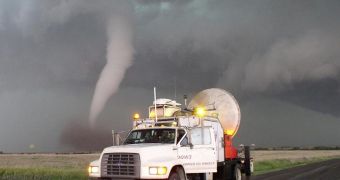An international group of investigators has just finished the most dangerous stages of the Verification of the Origins of Rotation in Tornadoes Experiment (VORTEX2). The general goal of the undertaking was to determine why certain storms turn into tornadoes, while others don't. No groundbreaking conclusions were derived from the months of study, but the scientists involved say that they managed to collect vast amounts of data on storms, which will undoubtedly help them get more clues on various weather patterns, OurAmazingPlanet reports.
VORTEX2 was the largest-ever research effort into tornadoes. It featured hundreds of scientists and tens of specialized vehicles. All participants drove directly into the path of twisters and similar features, and deployed specialized equipment to conduct measurements. It could be said that the information gathered in this manner will considerably improve tornado warnings and short-term weather forecasts. For now, experts will just have to settle with being able to announce people in time that a tornado is coming. Undoubtedly, future studies will also allow them to gain a complete understanding of the causes that generate these atmospheric manifestations.
“We're studying something that's not just an academic curiosity. It will help people that live in fear of tornadoes,” says Joshua Wurman, a team member that has been involved in collecting this type of data for over 10 years. He is based in Boulder, Colorado, at the Center for Severe Weather Research, and has been featured in the show Storm Chasers. The expert explains that the new investigation, which was worth about $12 million, was the follow-up on the original VORTEX experiment, which took place in 1994 and 1995.
“Eventually we'd like to be able to give tornado warnings that are similar to hurricanes warnings with intensity, timing and where it's going to go. Residents know the category of a hurricane before it hits,” the expert says. The study took place in the Great Plains, an area in the United States that is extremely prone to experiencing the devastating effects of twisters and tornadoes. The investigation was funded with grant money secured from the US National Science Foundation (NSF) and the National Oceanic and Atmospheric Administration (NOAA).

 14 DAY TRIAL //
14 DAY TRIAL //